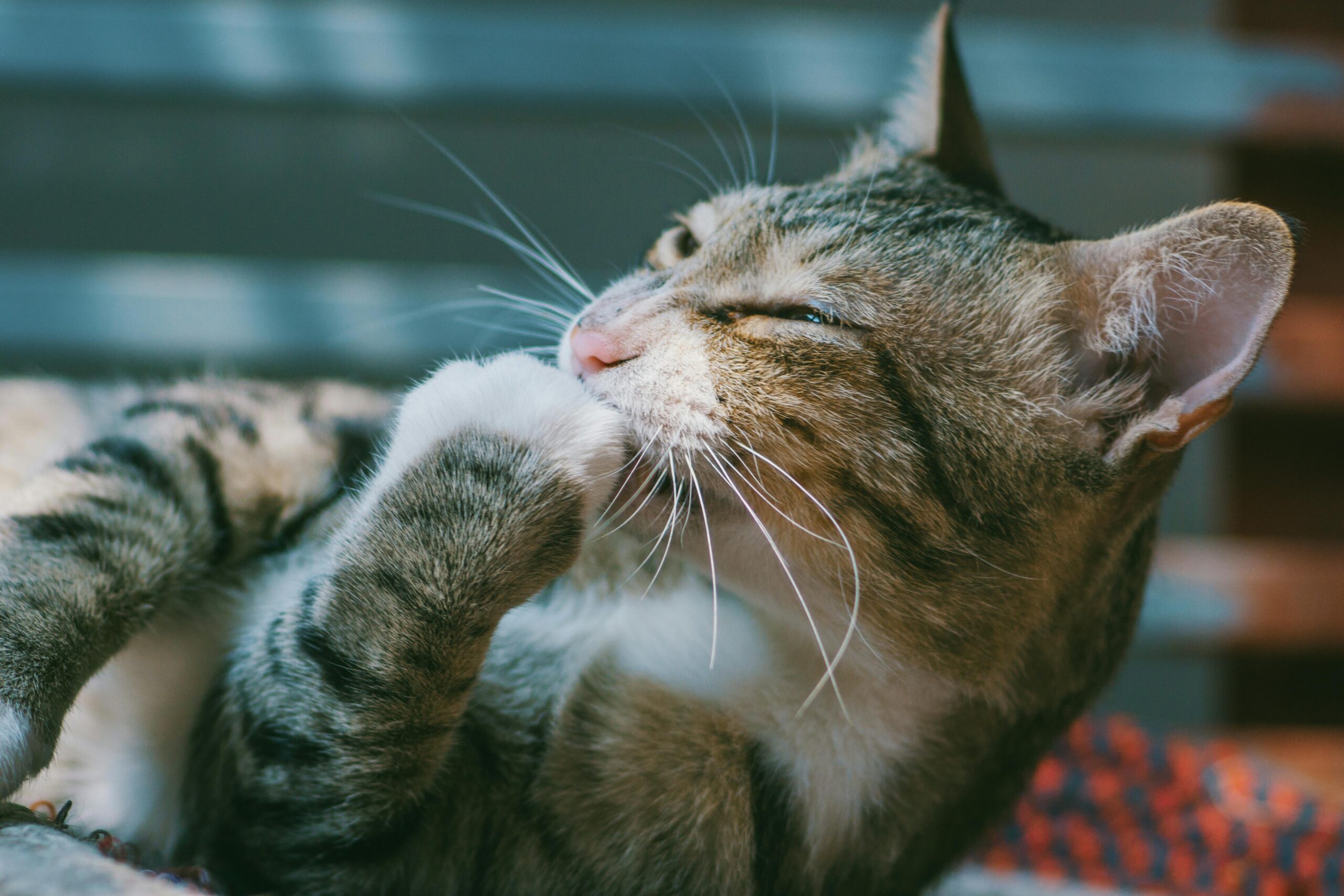As a devoted pet owner, you likely pay close attention to your cat’s health and grooming needs. However, sometimes issues arise with their skin that might not be immediately noticeable, especially if your cat is skilled at hiding discomfort. Skin conditions in cats can range from mild irritation to more serious health concerns, so it’s crucial to recognize the early signs of skin issues and know how to address them.
In this article, we’ll explore the common signs of skin conditions in cats, possible causes, and how you can effectively manage and treat them. Whether you’re dealing with shedding, dandruff, or more severe symptoms, understanding your cat’s skin health is key to ensuring their overall well-being.
Common Signs of Skin Conditions in Cats
Before delving into specific skin conditions, it’s important to note that certain symptoms indicate something is amiss with your cat’s skin or coat. Here are some common signs that could point to a skin condition:
1. Excessive Scratching or Grooming:
While occasional scratching is normal, persistent or excessive scratching, licking, or biting can indicate an underlying issue. If your cat is spending more time than usual grooming themselves or seems to be constantly scratching at a specific spot, it could be due to allergies, dry skin, or parasites like fleas.
2. Hair Loss (Alopecia)
If you notice that your cat is losing fur in patches or the fur appears thinner than usual, this could be a sign of a skin condition. Hair loss could result from flea infestations, allergies, infections, or stress. In some cases, it could also indicate a hormonal imbalance or underlying disease.
3. Bald Spots
Bald patches or thinning areas on your cat’s skin may suggest a fungal infection, mange, or a parasitic infestation. Cats with a weakened immune system are also more prone to these conditions.
4. Dandruff
If you see flakes of dry skin on your cat’s fur or bedding, it could be a sign of dry skin, nutritional deficiencies, or allergies. Dandruff is often accompanied by other signs such as itching and redness.
5. Red, Inflamed, or Scaly Skin:
If your cat’s skin looks red, swollen, or irritated, it could be inflamed due to an allergic reaction, bacterial infection, or parasite infestation. Scaly patches or crusts on the skin are also common symptoms of skin infections or fungal conditions like ringworm.
6. Changes in Fur Color or Texture:
If you notice that your cat’s fur is changing color or becoming dull, it could indicate an issue with their skin health or a dietary deficiency. A healthy coat is shiny and soft, but a lack of essential nutrients or exposure to environmental stressors can affect its appearance.
7. Odor
A strong, unpleasant smell from your cat’s coat or skin can point to bacterial or fungal infections, especially if combined with visible signs of inflammation or discharge. Odor can also occur when your cat has a poor grooming routine due to discomfort or stress.
8. Swelling or Bumps
Swelling, bumps, or lumps on your cat’s skin could be a sign of a variety of skin conditions, including abscesses (often caused by bites), cysts, or tumors. If the bumps are warm to the touch or your cat is in pain, this could require immediate veterinary attention.
Common Skin Conditions in Cats and Their Causes
Now that you’re familiar with the signs to look for, let’s explore some common skin conditions in cats and what may be causing them.
1. Fleas and Other Parasites
Fleas are one of the most common causes of skin problems in cats. These tiny, irritating pests feed on your cat’s blood, causing itching, scratching, and sometimes even allergic reactions. The constant scratching can lead to hair loss, sores, and infection. Other parasites like mites, ticks, and lice can also cause similar symptoms.
What to Do: Regularly use a flea comb to check your cat’s fur for fleas or flea dirt (tiny black specks), especially around the neck, tail, and underbelly. Flea treatments, including topical medications and flea baths, can help prevent and treat infestations. If your cat is allergic to flea bites, your vet may prescribe medication to relieve itching and inflammation.
2. Dry Skin
Cats with dry skin may experience flaky skin, dandruff, and excessive scratching. This condition is often more common in the winter months when indoor heating can dry out the air. Dry skin can also result from bathing your cat too frequently or using harsh shampoos.
What to Do: To combat dry skin, ensure that you’re using a gentle cat shampoo and cat conditioner. Hydrating baths with products designed for sensitive skin can help. If your cat has particularly dry skin, consider adding an omega-3 supplement to their diet to improve skin health. A humidifier in your home can also help prevent dry skin in cats living in areas with low humidity.
3. Allergies
Like humans, cats can suffer from allergies. These can be environmental (such as pollen or dust mites), food-related, or caused by grooming products or chemicals. Allergies often result in itching, hair loss, and skin irritation.
What to Do: If you suspect your cat has allergies, try to determine the cause. If it’s a food allergy, you may need to adjust their diet or try a hypoallergenic food formula. If it’s an environmental allergy, reducing exposure to allergens and using hypoallergenic grooming products can help. In some cases, your vet may recommend antihistamines or steroids to control the symptoms.
4. Ringworm
Ringworm is a fungal infection that causes circular patches of hair loss, often with a scaly or crusted appearance. It is contagious and can spread to other pets or humans. The infection is caused by a fungus, not a worm.
What to Do: If you notice ring-shaped bald spots, it’s important to isolate your cat from other animals and take them to the vet for diagnosis and treatment. Ringworm is usually treated with antifungal medications, topical ointments, and proper hygiene.
5. Hot Spots (Acute Moist Dermatitis)
Hot spots are painful, inflamed areas of the skin that can appear suddenly. They are typically caused by excessive scratching, licking, or biting, often due to allergies, insect bites, or skin infections. Hot spots can quickly become infected and require prompt treatment.
What to Do: Clean the affected area with an ear cleaner or antiseptic solution and apply a soothing ointment recommended by your vet. In some cases, your vet may prescribe antibiotics or corticosteroids to reduce inflammation. Preventing your cat from licking the area is essential, and an Elizabethan collar may be necessary to stop further irritation.
6. Seborrhea
Seborrhea is a condition that leads to greasy, flaky skin. It can be caused by a variety of factors, including hormonal imbalances, allergies, or underlying health problems. Seborrhea may cause your cat to have an oily or scaly coat.
What to Do: Seborrhea can often be managed with regular grooming and using specialized cat shampoos designed for oily or flaky skin. Your vet may also recommend dietary changes or medication if the condition is caused by an underlying health issue.
7. Skin Infections
Bacterial infections can develop when your cat’s skin is irritated or injured, such as from excessive scratching or bites. These infections often result in redness, swelling, and pus-filled bumps.
What to Do: If you suspect your cat has a skin infection, visit the vet for diagnosis and antibiotic treatment. Regular grooming and proper hygiene can help prevent skin infections from occurring.
What to Do If You Notice Skin Problems
If you observe any signs of skin issues in your cat, it’s essential to take action promptly. Here are some steps to follow:
- Examine Your Cat Closely: Look for signs of flea infestations, irritation, hair loss, or bumps. Use a flea comb to check for parasites, and gently part your cat’s fur to examine the skin underneath.
- Use Proper Grooming Tools: Regular brushing, nail trimming, and bathing with appropriate cat grooming products can help maintain healthy skin and coat. Be sure to use cat grooming gloves or brushes that are suitable for your cat’s coat type.
- Monitor Your Cat’s Behavior: If your cat is excessively grooming, scratching, or licking a particular area, try to identify the underlying cause. If the behavior persists, it may be time to visit the vet.
- Seek Veterinary Help: If the skin condition appears severe or doesn’t improve with basic home care, schedule a visit to your vet. They can perform tests, make a diagnosis, and recommend the best course of treatment.
Conclusion
Keeping an eye on your cat’s skin health is essential for their overall well-being. By recognizing the early signs of skin conditions, such as excessive scratching, hair loss, and irritation, you can take prompt action to alleviate discomfort and prevent further complications. Whether you’re dealing with a common condition like dry skin or something more serious like a fungal infection, your vet will be your best resource for diagnosis and treatment.
With the right tools, such as grooming brushes, nail clippers, and hypoallergenic products, and by providing regular care and attention, you can help your cat maintain healthy, beautiful skin.






